The Scrap Drawer: How to Keep Time
Maya Deren, Joanna Newsom, The Uses of Enchantment, Italo Calvino, Joseph Cornell
The Scrap Drawer is a monthly 'quilt' assembled from fragments—disparate thoughts, quotations, inspirations, photographs, works in progress, and bits of life. It is a space for awareness of the interconnectedness of all things, people, places, and times.
Dear Someone,
How do you let go of the day?
How do you relax into the evening without resistance?
The truth is that I do not know; at least not in any lasting sense.
Often, when my body finally enters into comfortable rhythm with time, the debt collector calls to interrupt my exaltations.
It is true that there are moments where I am able to loosen my grip on the hours. My only evidence of this is in the art I make. Without a pen, or needle and thread in hand, I white knuckle through my days.
Having a tool in my hand helps me to become more delicate; in my gestures, in my attention, and in my words. When I am fully present with what I am making, I am free from the dread of watching the hours pass. When I am stitching or writing letter, I am aware that time is a spiral reaching towards a center, and not a march off of a cliff.
While auditing my time expenditures this month, I noticed I spend most of my time collecting and arranging things. I keep figurines, phrases, fabric scraps, and ephemera tucked away in drawers. I arrange these things into constellations that, in my imagination, connect past and future.
You might look at these arrangements of tchotchkes and helicopter seeds and call it hoarding—I’m willing to accept that dose of reality. So why don’t you take some of my dream?
I don’t immediately know why I am compelled to keep a thing, but I’ve learned to do so in the same way a child collects pebbles, shells, and feathers. The child stuffing these things into their pockets knows the immensity of small things, and by extension, the immensity of themselves.
Ironically, this habit of mine takes up a lot of time by itself, and causes much friction with my world responsibilities, which in my opinion, are of much lesser importance than the photos I take of my dollhouse.
The following are scraps I’ve kept for the month of May. Each one circles around the concept of time itself, and the thresholds between waking and dreaming, memory and presence.
As a practice, The Scrap Drawer has helped me keep time and hold it close—not as something to possess, but to be inside of.
Art isn't an interruption of life, or an asside to it -- it is life. Slowed down, held in your hands, and fully seen. Any one thing next to another thing tells a story.
Here are this month’s scraps. Do you have any to add?
1. Meshes of the Afternoon (1943)
Do you remember your dreams? I hardly ever remember mine; years of disordered sleeping has barred me from the dream world.
But sometimes I'm able to hold onto a single image. I might wake up with a sensation of falling, which proves that despite my forgetfulness, I do live half of my life in there. So, it must be an important part of myself to get to know.
In Maya Deren's iconic short film, Meshes of the Afternoon, the circular path the artist walks in it feels eerily familiar.
Any attempt to describe Meshes tends to flatten it. I would recommend that you watch it on your own. All I ask is that you notice the porosity Deren shows between waking and dreaming. These two states are not isolated. One is not any more real than the other; It's only the self experienced from two separate vantage point.
2. Be Here Now
It is satisfying to feel the days stack up in the thickness of your journal. It is shocking to return to a draft even after only a few days to strike out what you yourself wrote before. It is sometimes uncomfortable to make something, but always worth the proof of life you leave for yourself.
The process of creation by nature involves this observation of ourselves changing across time. Sometimes we will squirm beneath our own gaze. With practice, we learn to watch ourselves lovingly where we used to scrutinize.
It is in this returning to oneself on the page we can gain an ariel perspective which makes it possible to bring ourselves to a higher experience of life.
3. A Quilt Project
When I began working on this quilt in January, I was determined to control every aspect of the process. I drafted a pattern onto brown packing paper, carefully cut out my pieces, starched and pressed them. But once I began pinning everything down to the muslin, the puckers appeared—all the imprecision in my cuts suddenly visible.
It took several weeks just to cut the pieces and find a pleasing composition before I could begin hand sewing. By then, I wasn't even sure I liked my fabric choices anymore.
I would stuff it in a drawer periodically, returning only when I felt a renewed tenderness toward it. Eventually, it came together as if in a dream—all the pressing and pinning somehow balancing the structured planning of composition with the visibility of human touch.
4. Time, As a Symptom
Joanna Newsom has always been one of my favorite artists; I think this must be because we are both collectors of scraps. In her album Divers, Newsom narrators engage in some form of diving: a fall from a plane, or other various forms of decent. This is a snippet of her lyrics from “Time, As a Symptom:”
The moment of your greatest joy sustains
Not axe nor hammer
Tumor, tremor
Can take it away, and it remains
It remainsAnd it pains me to say, I was wrong
Love is not a symptom of time
Time is just a symptom of love
5. Italo Calvino’s memo on Visibility
The work of Italo Calvino has been hugely influential for me this year. In his writing, he approaches the most monumental and serious topics with a sense of play.
As his parting gift to the world, Calvino left a series of lectures titled "6 Memos for the Next Millennium," which discuss the overarching history of literature alongside the development of technology. The "memos" proposed are presented as a way for a writer to circumvent the challenges presented by the age of technology.
Calvino positions the values of Lightness, Quickness, Exactitude, Visibility, Multiplicity, and Consistency as guideposts for writing through the next millennium. I discussed the first lecture in my first Scrap Drawer entry.
In his memo on Visibility, Calvino speaks to the importance of the mind to strengthen and preserve its ability to bring forward an inward image.
In 6 memos, Calvino reminds his readers that in the beginning of time images were tied to direct experience. As communication technology developed, so did a person's exposure to images.
Calvino lived between the years of 1923 and 1985. In his lecture on visibility, he recalls his experience in seeing this ever growing daily influx of images.
Even in 1985, Calvino could see that the saturation of images in the modern mind could pose as a threat to a person's ability to summon their own inner images.
6. Mother’s Day
Mom dropped by on mothers day weekend. We spent the day together as we usually do: perusing thrift stores and yard sales, and continuing our 32-year-long conversation about the family drama.
Before she left, I asked her to make a room in my doll house so I could take a photo of it. She initially resisted, saying "I'm not good at that artsy stuff" although we had seen her spend the whole day rummaging for tiny treasures in thrift stores.
7. The Uses of Enchantment
While my mother was visiting, I asked her a question I'd never thought to ask her before: what stories shaped your childhood?
I thought to ask this because I've been reading Bruno Bettelheim's "The Uses of Enchantment: the Meaning and Importance of Fairytales."
Published in 1976, the book laments the trend to emphasize rationality in children's storytelling.
Children cannot do not yet have the ability to understand the world rationally. My mother was displaced as a child, and did not have much access to story telling. I grew up on Disney and harry potter, receiving my storytelling through corporatized filters such as Disney or the Harry Potter series.
I realized through this line of questioning how hard earned my access to the symbolic world has been for me. I had to reclaiming a narrative sovereignty for myself, outside of the story telling fed to me my corporate entities
In my family, there has been very little tine for leisure, which has made so little room for narrative sovereignty. How do we craft our our own stories, and therefore construct our own meaning from life with such little tiem?
8. Joseph Cornell
In my reading, I have focused on Joseph Cornell. He wandered around his New York throughout his artistic career collecting detritus, which he obsessively archived and assembled into arrangements for his shadow box assemblages.
He also kept scraps of his observations and impressions written on spare paper and loose napkins, and ticket stubs, which were carefully filed away. He seemed to view the world as material world before a human world, considering the importance of the smallest of fragments to the whole.
His diaries indicate that he was both overwhelmed by his inspiration, and burdened by it. He must have known it would be impossible to catalogue every last butterfly wing and button, but he certainly did try his best.
His work, to me, seems to be an effort to restore the value to small things in a lifetime where the world shifted towards a focus on the immaterial.
9 The Dollhouse Project
As friends visit lately, I invite them to spend some time making their own rooms in the dollhouse before they go. The rooms always feel like a shared dream; a collaboration between myself and everyone in my life.
My mom discovered he tub and sink out of Goodwill bins. Em make tiny sculpture out of bits of paper. David wallpapered it’s walls with bits of paper. I strewn in tiny gems an pearls throughout the scene, curated the lighting, and snapped the photo. I’m looking forward to making a photo album of friend’s visits in this way.
10. Awakening from the Meaning Crisis
We have become strangers to our own world. Everyone is drowning in and ocean of bullshit, and deeply distracted from what is real. John Vervaeke is a cognitive scientist who created this series of lectures to unravel the intricacies of this crisis, and what it would mean to return to lives full of meaning. I highly recommend that you watch this series of lectures and consider what is most real in your life, what is bullshit, and how to return to your own humanity and sense of what is real.



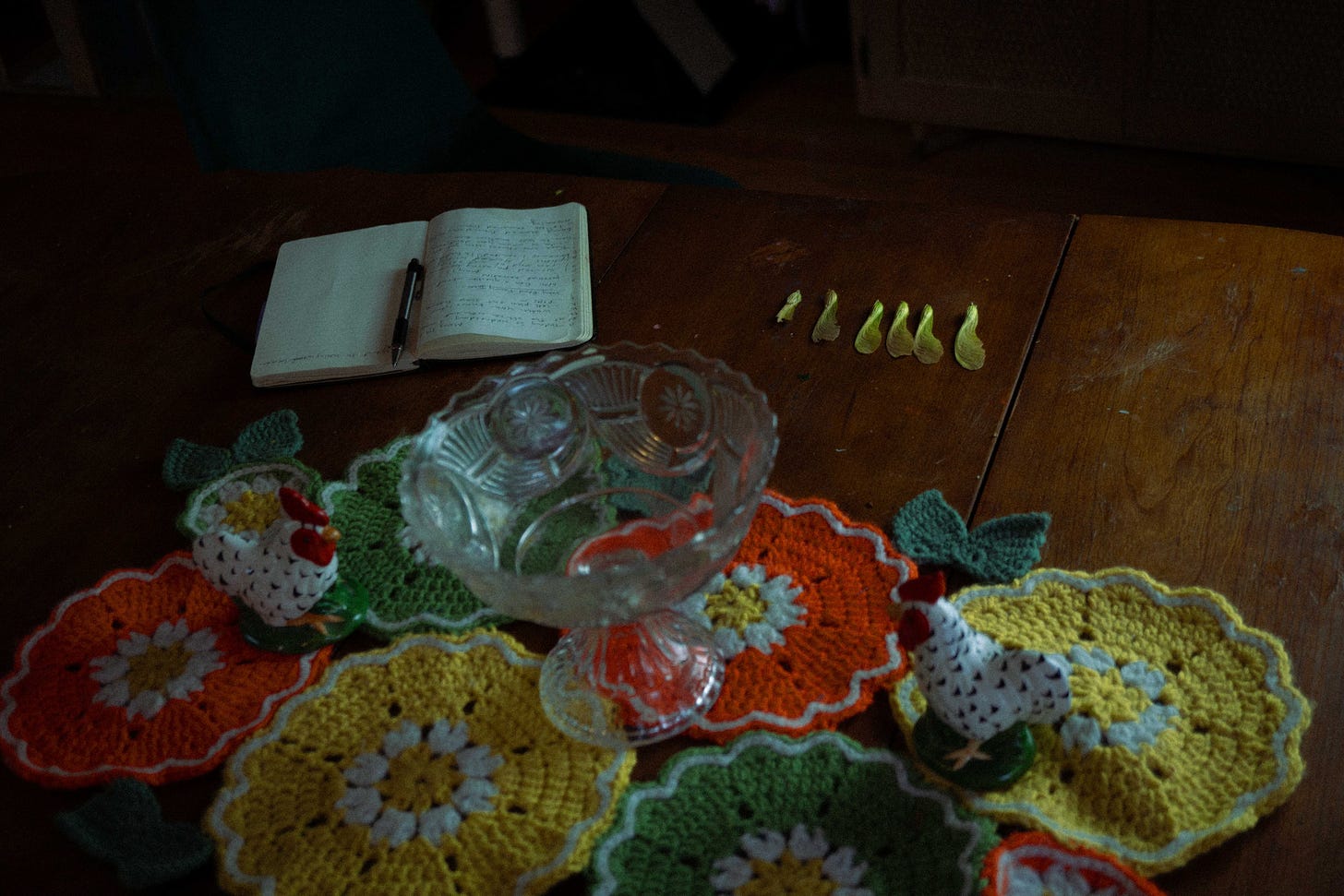
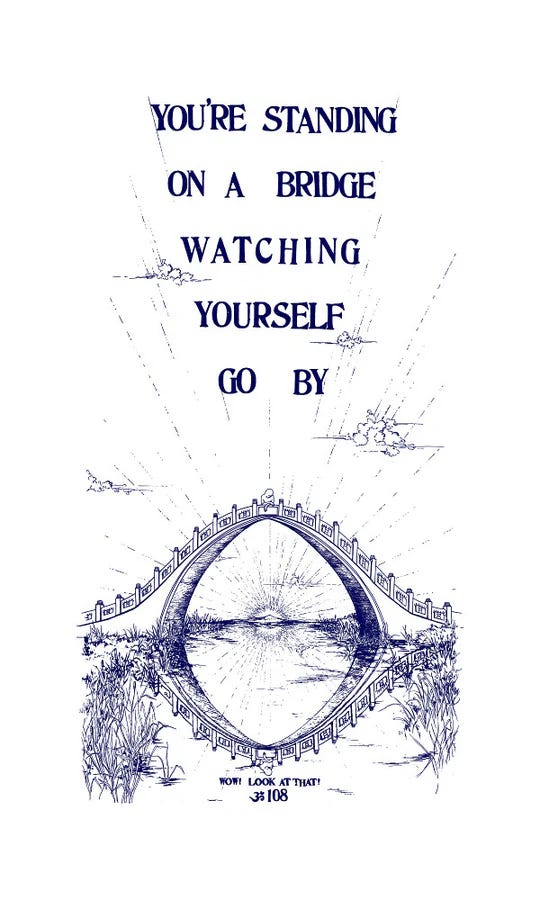
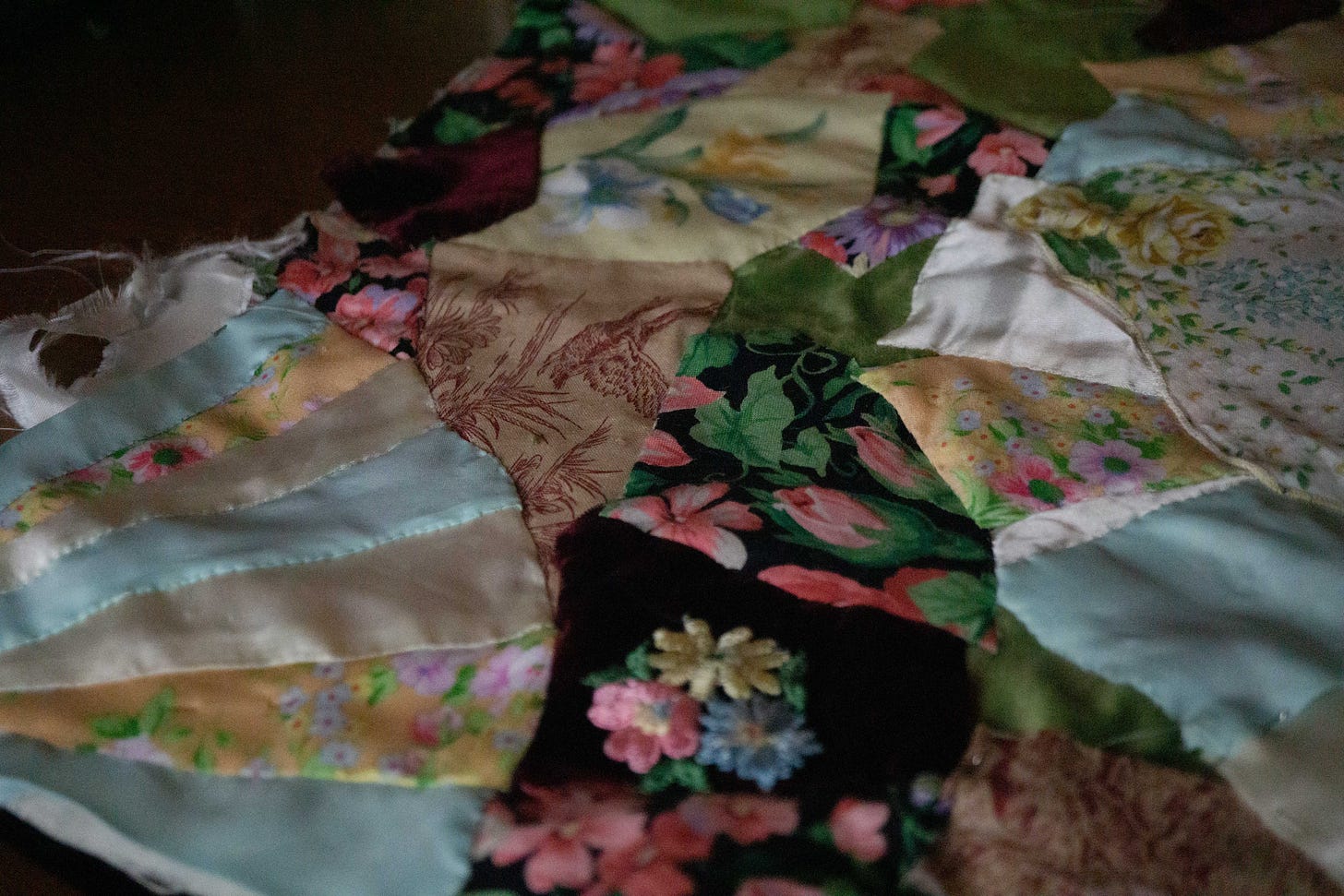
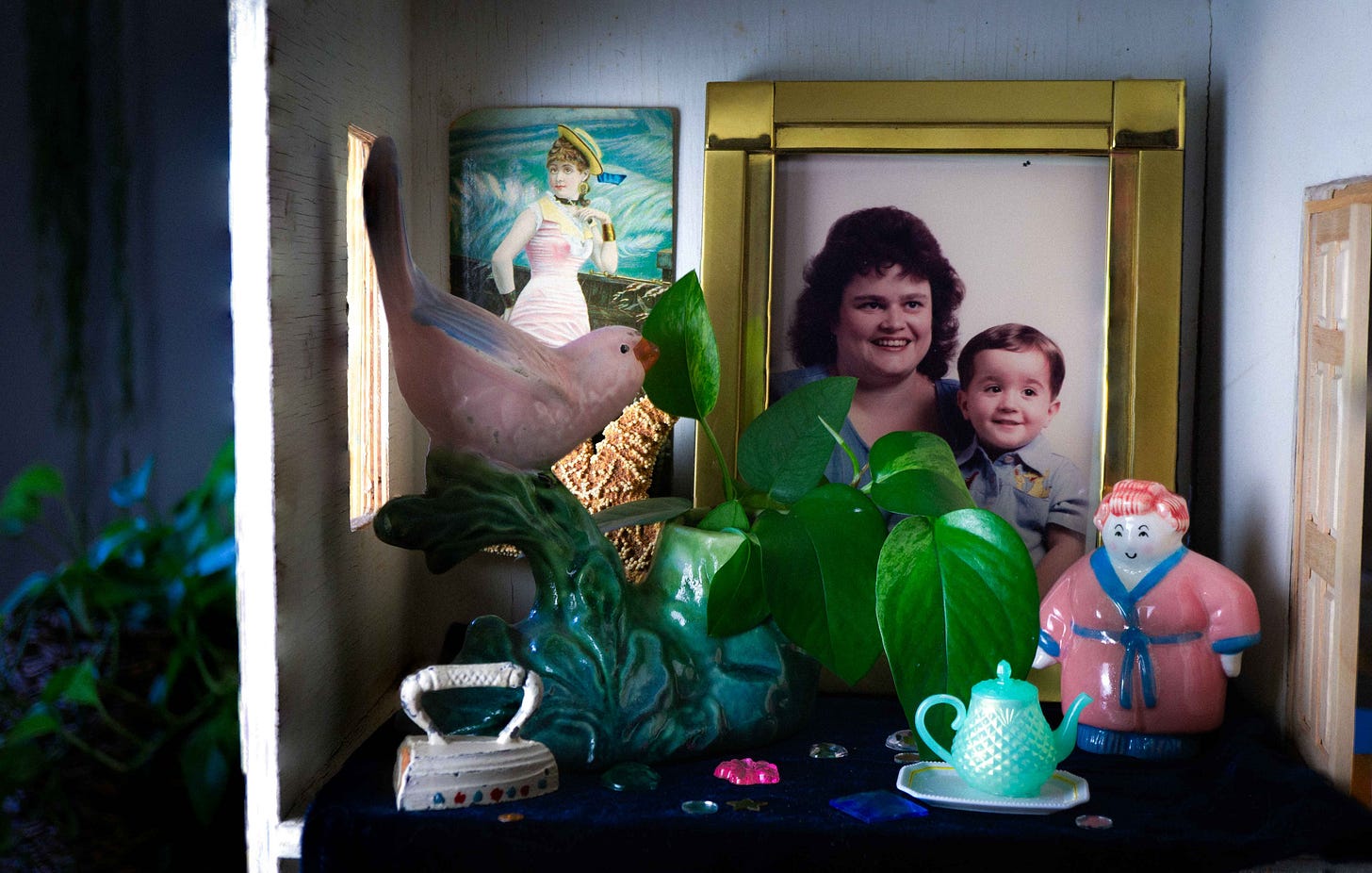
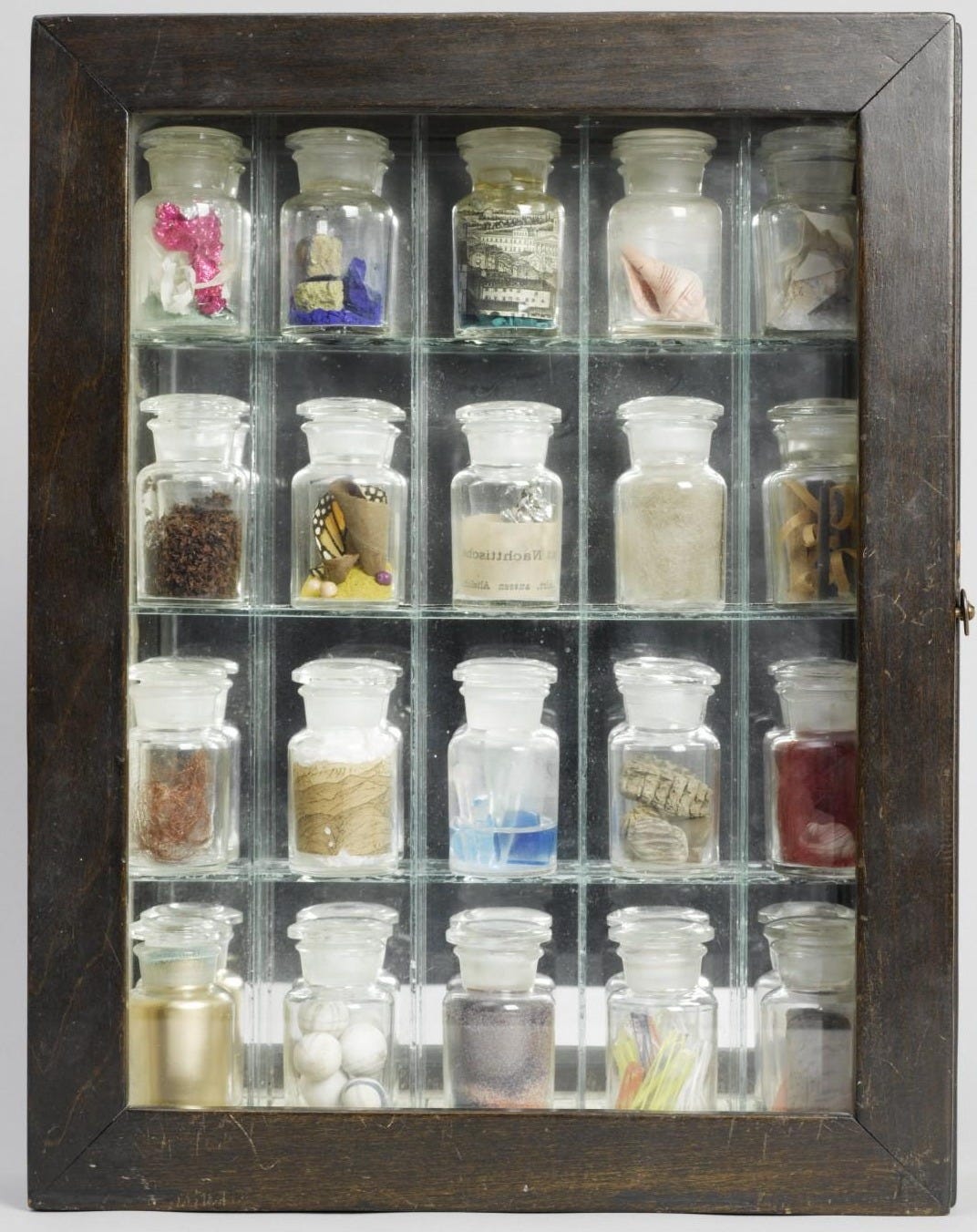
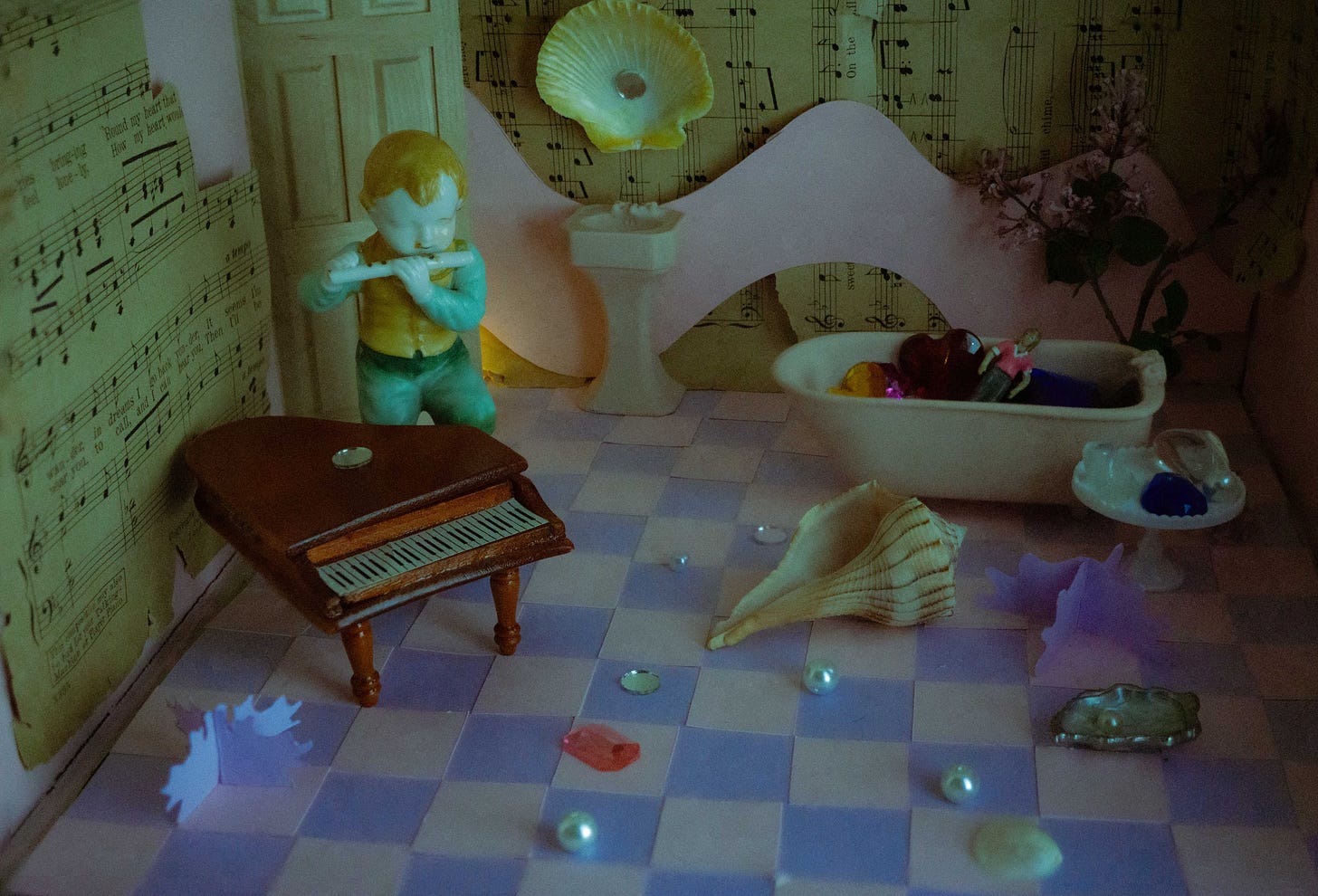
The miniature photo turned out great. Thanks for the experience.
Deren, Calvino, Cornell, all of my favorite people.